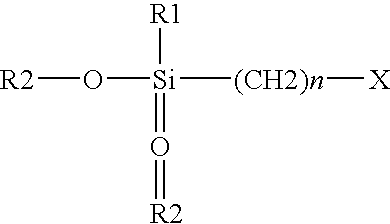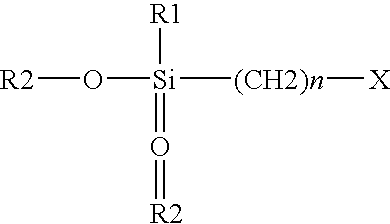Coating composition and optical mar-resistant tintable coating
a coating composition and tintable coating technology, applied in coatings, optics, instruments, etc., can solve the problems of poor adhesion of subsequently applied antireflective coatings, severely limit the use of these coatings, poor mar resistance, etc., to achieve greater transparency, improve light transmission, and improve clarity
- Summary
- Abstract
- Description
- Claims
- Application Information
AI Technical Summary
Benefits of technology
Problems solved by technology
Method used
Image
Examples
example 1
Tintable, Highly Mar Resistant Coating of the Present Invention
[0061]The following example of the present invention is for illustrative purposes only and is not intended to limit the scope of the invention.
Formula:
[0062]
Parts byMaterialWeight(1)3-glycidoxypropyltrimethoxysilane (Degussa)55.19(2)deionized water6.31(3)Miramer ® M4004 acrylated polyester oligomer (Rahn)10.00(4)1,4-butanediol diacrylate (Sartomer)20.00(5)dipentaerythritol hexaacrylate (Rahn)10.00(6)BYK 333 disperse dye (BYK Chemie)0.50(7)Darocur ® 1173 (Ciba Specialty Chemicals)4.00(8)Cyracure ® 6976 (Dow Chemical)4.00Subtotal110.00methanol lost via evaporation−10.00Total100.00
Preparation Procedure:
The above materials at room temperature were combined in the listed order in a clean, dry, open mixing vessel equipped with a means of agitation. After adding the deionized water, the mixture was allowed to stir in the open vessel for 24 hours to effect hydrolysis and allowed to come to equilibrium before adding the remaining...
PUM
| Property | Measurement | Unit |
|---|---|---|
| temperature | aaaaa | aaaaa |
| temperature | aaaaa | aaaaa |
| weight percent | aaaaa | aaaaa |
Abstract
Description
Claims
Application Information
 Login to View More
Login to View More - R&D
- Intellectual Property
- Life Sciences
- Materials
- Tech Scout
- Unparalleled Data Quality
- Higher Quality Content
- 60% Fewer Hallucinations
Browse by: Latest US Patents, China's latest patents, Technical Efficacy Thesaurus, Application Domain, Technology Topic, Popular Technical Reports.
© 2025 PatSnap. All rights reserved.Legal|Privacy policy|Modern Slavery Act Transparency Statement|Sitemap|About US| Contact US: help@patsnap.com



